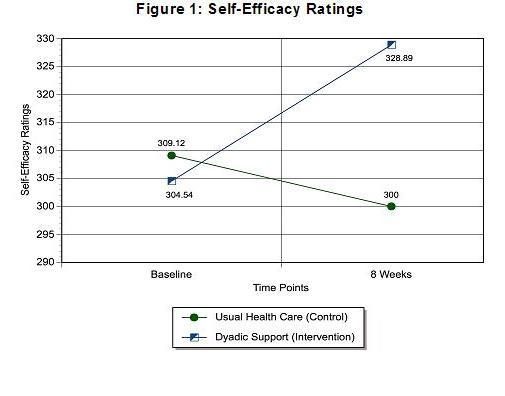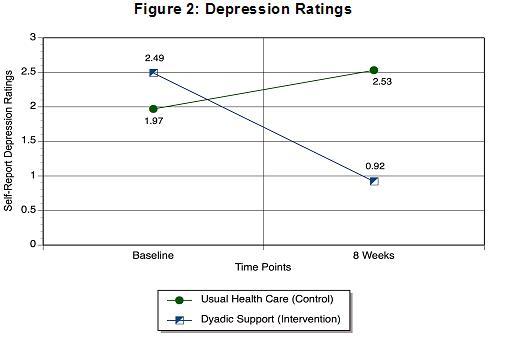The Implementation Guide is a resource for implementing this evidence-based program. It provides important information about the staffing and functions necessary for administering this program in the user's setting. Additionally, the steps needed to carry out the program, relevant program materials, and information for evaluating the program are included. The Implementation Guide can be viewed and downloaded on the Program Materials page.
Program Synopsis
Designed to enhance the quality of life of individuals who have been diagnosed with prostate cancer and have undergone a radical prostatectomy, this intervention consists of one-on-one peer support from a trained prostate cancer survivor well matched to the patient who meets with the patient so they can share their thoughts and feelings about their cancer experience. The study showed increased self-efficacy and decreased depression.
Program Highlights
Program Materials
Preview, download, or order free materials on a CD
Implementation Guide
Download Implementation Guide
Program Scores
The Need
Prostate cancer is the leading source of solid-organ cancer in American male seniors according to the American Cancer Society (2003). More than 75% of diagnosed cases occur in men over the age of 65. If discovered early, the survival rates for this form of cancer are as high as 93%. Unfortunately, survivorship is often complicated by treatment side effects that include urinary, bowel, sexual, and hormonal dysfunction. For example, the prevalence of urinary incontinence following radical prostatectomy is anywhere from 8 to 59%, while erectile dysfunction affects 30-80% of these men. The longstanding, functional declines after radical prostatectomy coupled with the necessary accommodations in lifestyle result in a complicated pattern of change in a man's quality of life, even after adjusting for presurgical demographic and psychosocial factors.
Usual health care programs of social support focus on meeting educational and informational needs of men, but they may not satisfy the emotional needs after radical prostatectomy, and they do not support strategies that include individually tailored programs of peer-to-peer (dyadic) support. The development of a dyadic intervention has been guided by Bandura's (1997) self-efficacy theory. Self-efficacy, as the term is used here, refers to the perception that one has control over events and situations shaping one's life, and one is therefore able to achieve a desired goal or outcome. The dyadic intervention promotes the sharing of thoughts, feelings, and emotions with another man who has successfully adjusted to the negative side effects that accompany a radical prostatectomy. The process is anticipated to increase social support, decrease feelings of depression, and thus empower the man who has recently undergone a prostatectomy.
The Program
Dyadic Support for Men with Prostate Cancer is an individualized, one-on-one, peer support program for men 45 years or older who have had radical prostatectomy 6 weeks earlier and whose original prostate cancer diagnosis has been made within the previous 3 months. The dyadic (peer-to-peer) support partners are recruited from a core group of men who had a radical prostatectomy at least 3 years earlier. The men are trained according to a strict protocol to recognize signs and symptoms of clinical depression, communicate with active listening skills, and record the reaction of participants to the weekly support session in a standardized log format. The primary role of the dyadic support person is to share personal thoughts and personal experience relevant to prostate cancer from the unique perspective of a prostate cancer survivor. The dyadic partner is not a replacement for professional health care providers.
Dyadic support partners are identified by participating urologists from a pool of former patients whom the urologists feel have had a successful recovery from radical prostatectomy but who also experienced side effects of urinary, bowel, sexual, and hormonal dysfunction. The two men making up the dyad-- the one who successfully recovered from a prostatectomy ("survivor") and the one who is the recent patient-- are matched by treatment, side effect profile, and race. The men meet 8 times over a 60-day period for lectures, discussion, and role-play to bring forth personal thoughts and feelings. Dyadic support meetings take place in locations with a relaxed atmosphere that will allow for private conversation, such as a coffee house, and take place away from significant others whose presence might inhibit free discussion of embarrassing topics associated with recovery. The two men share common experiences and develop strategies for effective communication with loved ones and significant others. Topics addressed during the 60-day program include erectile dysfunction, intimacy versus sexuality, incontinence, unexpected reactions, and dealing with overwhelming feelings that may be brought to the surface.
Time Required
The time required to implement Dyadic Support for Men with Prostate Cancer includes--
- Formal 3-6 hour training course for dyadic support partners conducted by the advanced-practice nurse
- 8 weekly meetings lasting an average of 65 minutes each; individual meetings vary widely and the length of each meeting may also vary depending on the issues and reactions that surface.
Intended Audience
The intervention targets men 45 years and older who have had a radical prostatectomy for prostate cancer 6 weeks earlier (typically within 3 months of the prostate cancer diagnosis).
Suitable Settings
The intervention is suitable for non-clinical, community-based, informal, and relaxed settings such as a coffee house or park that will facilitate private conversation and free discussion of topics associated with recovery.
Required Resources
The required resources for program implementation include the following:
- Clinical consultation resource:
A clinical program manager, preferably an advanced-practice nurse who assumes clinical and day-to-day operational responsibility for the program. The nurse assumes the clinical responsibility for monitoring the dyadic session logs and providing professional guidance on any clinical psychological issues that cannot be addressed by the dyadic partner. The health care professional who clinically oversees and manages the program also ensures program fidelity around training procedures and program implementation
- Training manual called Friends-for-Life: Support Partner Training Manual including the Dyadic Education Session Curriculum and training pamphlets.
Other Resources include--
- A pool of urology clinics affiliated with tertiary care medical centers from which men who recovered from a radical prostatectomy at least 3 years previously ("survivors") can be recruited as dyadic partners
- Identified dyadic partners (matched to recent surgery patients by treatment, race and similar surgical side effect profile)
About the Study
A randomized control design was used to compare the effects of an 8-week program of peer-to-peer (dyadic) support to usual health care on three outcome variables (self-efficacy, depression, and social support). The study evaluated 72 male volunteers with an average age of 60 years (range: 47-74 years) who had undergone radical prostatectomy for prostate cancer 6 weeks earlier. Most participants (82.5%) were White, and the majority (85.7%) had no support group history. All participants were within 100 days of the original prostate cancer diagnosis. None of the participants had a history of psychiatric disorders or cancer, and there was no history of death of a loved one within 1 year of study recruitment.
Participating urologists recruited an initial core group of 11 dyadic support partners (9 White and 2 African American men) from a pool of former patients who had a prostatectomy at least 3 years earlier with a successful recovery but a similar history of side effects. The support partners were trained to recognize and record symptoms of clinical depression, use active listening skills, and record participants' reactions.
Participants were randomized into two groups: the usual health care (control) condition and the dyadic condition plus usual health care. Both groups received the usual health care their urologists provided, but the dyadic group also met eight times over an 8-week period with their support partners. The average session was 65 minutes, ranging from 5 minutes to 360 minutes. Dyadic partners were matched to participants in the intervention condition by race and common surgical side effects.
Self-report questionnaires for depression (15-item, Geriatric Depression Scale), self-efficacy (38-item, Stanford Inventory of Cancer Patient Adjustment), social support (41-item, Modified Inventory of Socially Supportive Behaviors), and incontinence and erectile dysfunction (UCLA Prostate Cancer Index on 15 disease-related items) were administered by telephone to all participants at baseline, at 4 weeks, and at 8 weeks following study entry.
Key Findings
- Participants in the dyadic support condition reported higher self-efficacy ratings at 8 weeks (M=328.89) compared to the self-efficacy ratings (M=300.00) reported by the usual care participants (p=0.005). A medium effect size (Cohen's d= -.685) was associated with this increase in self-efficacy ratings.

- Participants in the dyadic support condition reported lower depression ratings at 8 weeks (M=0.92) compared to the depression ratings reported (M=2.53) by participants in the usual care condition (p=0.020).
Controlling for the different baseline levels of self-efficacy, social support, and depression across the two groups, the decrease in depression ratings at 8 weeks continued to show a significant difference for the dyadic condition compared to the usual care control condition (p=0.032). A medium effect size (Cohen's d=0.519) was associated with this improvement in depression ratings.

- The dyadic support condition had no effect on social support from others as defined by the 41-item Modified Inventory of Socially Supportive Behaviors.
- High social acceptance of this peer-to-peer support was inferred since all men in the dyadic condition met with their partner for most sessions (M=7 meetings), while none of the men in either the usual care or the dyadic conditions attended any traditional support groups during the study.
Publications
Weber, B.A. Roberts, B.L. Yarandi, H. Mills, T.L. Chumbler, N.R. & Algood, C. (2007). Dyadic support and quality-of-life after radical prostatectomy. JMHG (Journal of Men's Health and Gender), 4 (2), 156-164.




